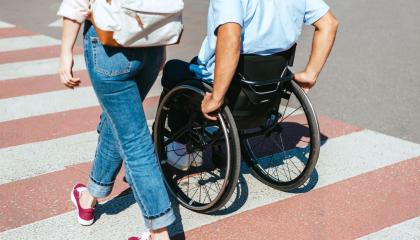First and foremost, detectable warning tiles and surfaces were designed to assist individuals with disabilities to safely navigate public spaces, and then, in 1991, the Americans with Disabilities Act (ADA) mandated the use of detectable warning tiles in public areas throughout the United States.
Individuals with disabilities must navigate a world designed for people with vision and mobility, and one tool that helps to make the world more accessible is navigational bar tiles. These directional tile surfaces consist of raised bars that align with the direction of pedestrian travel. These navigational directional bar tiles help people to locate the entrance to light rails, trains, and bus stops.
A companion to detectable warning tiles, navigational and directional bar tiles serve an essential purpose of guiding individuals with disabilities in the flow of traffic.
While the quality and durability of the detectable warning dome tiles are absolutely vital, they are only as good as their installation process. Let’s talk about installation processes.
Installation is when two or more materials are adhered together to form a strong bond. In this case, we have the detectable warning dome tiles that will be bonded to the substrate, the underlying substance or layer, with an adhesive. All the materials might be of the highest quality, but if the installation process is poor, then the integrity of the other materials will be compromised.
The development of larger cities grew exponentially in the past fifty years, leaving us with rapidly built cities that have given too little thought to the disabled members of their population. Now is the time to reassess how to be more inclusive in the built environment so that people of all abilities and diversity experience a living environment that meets their needs.
One result of population growth within cities is something called urban expansion, which is the unrestricted growth of housing, businesses, and roads without any specific planning. Urban expansion influences cities’ social and environmental dynamics, causing a number of disadvantages, including longer commutes, higher transportation costs, pollution, and loss of countryside.
The Americans with Disability Act outlines the standards required to make a parking lot ADA compliant, specifically when it comes to restriping the parking spots. Over time, the paint in parking lots fades, and it becomes more and more difficult to determine the parking spots. At this point, businesses are required to restripe their parking lot and to ensure that the parking lot is ADA compliant.
Traveling with a disability comes with unique opportunities and challenges, often requiring more research to find the best disability travel tips. No one should have to stay home due to a permanent or temporary condition. In fact, accessible travel is on the rise.
The travel industry offers more services and accommodations than ever before to individuals with impairments. With the internet on hand, individuals with disabilities often travel and share their own tips for getting around and exploring the world.
City planners and researchers claim that more and more people are moving into cities, which is contributing to something called urban density. This term refers to the number of people within an urban area. It’s a crucial factor for city planning — understanding how the city is functioning based on economics, health, geography, and sustainability.
The 2020 pandemic altered travel and affected so many tourism changes for towns, cities, and countries. Most vacations were canceled, and staycations, aka shutdowns or stay-at-home orders, reigned supreme.
Social distancing guidelines severely decrease how many people can be in any building at any given time, which has hurt restaurants, entertainment centers, and more. Not only do these changes impact brick and mortar stores — tax revenue and government budgets are also affected.
Objects do not possess color of their own. Our eyes perceive color as different wavelengths of light that bounce off things, and our brains process that information to help us interpret the world we see in vibrant color.
The visible spectrum lands between ultraviolet light and red light for humans, but scientists believe that humans can recognize up to 10 million colors.
Pagination
- Previous page
- Page 2
- Next page
Connect with us
We pride ourselves on our customer service, and we'd love to hear from you! Sign up for our newsletter to keep up with industry updates and trends, as well as any new product releases.












